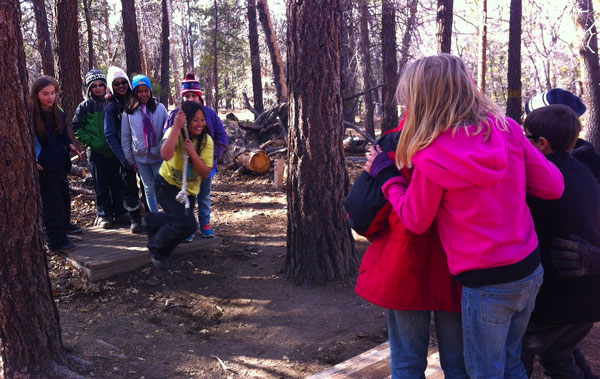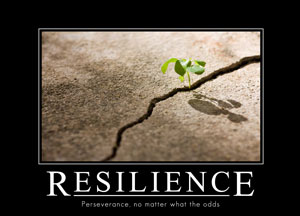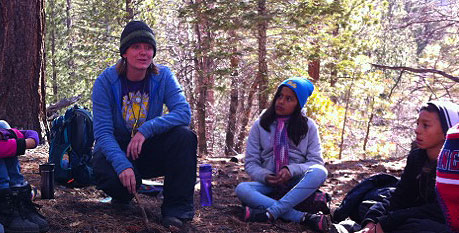I watch patiently as my student grabs hold of the rope, draws a breath, and leaps. He swings out across the gap of “molten lava” (the dirt and pine needles of the forest floor an inch below) amidst the cheers of his classmates. And then his feet hit the ground and drag. Once again, everyone is forced to return to the beginning and start again.
It is the sixth time this failure has happened, and the chorus of groans is growing louder with each attempt.

I run this activity once a week with my field group during our Adventure Course class, the point of which is to help students hone their communication and teamwork skills. Throughout this hour and a half (and ideally the rest of their week at High Trails) a lot of emphasis is placed on talking through problems and learning to think as a team. As I have watched group after group attempt these challenges, witnessed different students from different background with different strategies fall into a familiar pattern, a new idea has drawn my focus: my students are learning far more from their “failed” attempts than from their “successful” ones.
No one likes to fail.
 The very word is riddled with negative connotations: failing something in school is considered a testament to your intelligence; failing to get a job or opportunity you want feels like a denouncement of who you are as a person. Fear of failure holds many people back from even trying in the first place, and none of my students have ever liked the feeling of failing to complete an activity on the Adventure Course. When I ask them to describe how they feel between attempts, the most frequent things I hear are “frustrated” and “disappointed.”
The very word is riddled with negative connotations: failing something in school is considered a testament to your intelligence; failing to get a job or opportunity you want feels like a denouncement of who you are as a person. Fear of failure holds many people back from even trying in the first place, and none of my students have ever liked the feeling of failing to complete an activity on the Adventure Course. When I ask them to describe how they feel between attempts, the most frequent things I hear are “frustrated” and “disappointed.”
But the reward comes in their answers to my next question: “What can we change next time to help us succeed?”
Hands shoot up immediately in response, voices call out suggestions for nominating leaders and changing plans, and their vision is sharpened because they have had the chance to see things go wrong. They are more easily able to identify why they are frustrated, and once they know that, the solution becomes clear.
Enter Resilience
The idea of resilience in youth has been tossed around a lot in the media lately: the way children come to develop self-esteem and confidence even in the face of stress and adversity. 1Obviously this is a good thing, but how can we encourage the development of this trait? Some psychologists argue that the increasing social pressure placed on young people to perform perfectly at all times (in school, in sports, in social circles) has turned the idea of the occasional mistake or failure into something terrible.
If kids get used to succeeding at everything they attempt (or only attempting things at which they know they will succeed), their self-esteem is going to take a much greater hit when they finally encounter something that forces them to struggle. This is not building long-term resilience.

If we flip the argument around, though, then there is a lot of merit to teaching students that it is okay for their plans to not go perfectly the first time . . . or sometimes the second . . . or even the third . . . as long as they are taking something away from those experiences. While my students struggled to get across the river of molten lava time and time again, they were forced to think critically about the whole situation: why certain things were going well and why other things weren’t and what they could do to change it.
That is resilience – choosing to keep trying even when things are tough and not letting a lack of immediate results bring down morale.
 That’s the great thing about “failure” here at High Trails: it isn’t final. It doesn’t close a door; it opens up a discussion and offers a second chance. The first few times the students have to restart an activity, you can see the frustration on their faces; but once they realize that they can make changes and see a difference in the outcome, they start having fun with the mistakes they make along the way.
That’s the great thing about “failure” here at High Trails: it isn’t final. It doesn’t close a door; it opens up a discussion and offers a second chance. The first few times the students have to restart an activity, you can see the frustration on their faces; but once they realize that they can make changes and see a difference in the outcome, they start having fun with the mistakes they make along the way.
Trying wild new ideas and being okay with the possibility that they might not work out is science! Important scientific discoveries like penicillin, pacemakers, and x-rays were created out of accidents. If we don’t risk failure occasionally, we can never hope to grow. By providing a safe environment where trial and error is not only acceptable, but encouraged, hopefully we can show our students that failure is not something to be ashamed of; it is something to be treasured for the things it can teach us.
MORE: Here’s a debate on this topic from NPR

At High Trails Outdoor Science School, we literally force our instructors to write about elementary outdoor education, teaching outside, learning outside, our dirty classroom (the forest…gosh), environmental science, outdoor science, and all other tree hugging student and kid loving things that keep us engaged, passionate, driven, loving our job, digging our life, and spreading the word to anyone whose attention we can hold for long enough to actually make it through reading this entire sentence. Whew…. www.dirtyclassroom.com
- http://www.healthychildren.org/English/healthy-living/emotional-wellness/Pages/Building-Resilience-in-Children.aspx. ↩

Comments are closed.